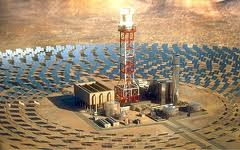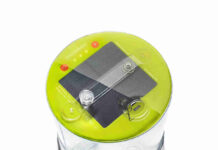
BrightSource Energy a company based in Oakland becomes an important solar thermal power company which is developing systems for generating power in absence of sun.
Now it is building one of the most world largest solar thermal power plants of about 392 MW in Ivanpah, California. According the company their technology can lower the costs of solar power making it more reliable in order to compete conventional sources of electricity.
Solar thermal systems are using mirrors to focus sunlight energy and to generate high temperatures to produce steams which drive turbines. The advantages of solar thermal approach versus conventional photovoltaics that convert solar power directly into electricity is about the heat can be stored cheaply and used when is necessary to generate electricity. All solar thermal power plants store heat into the fluids circulating through the system, being used in cloudy days.
BrightSource is using a decade old approach to store heat through the molten salt, a combination of sodium and potassium nitride stored in a tank. To generate electricity, the molten salt is pumped through a heat exchanger to generate steam. According to Brightsource CEO John Woolard, one big factor in making this technology economically attractive is the use of power towers.
There sunlight is focused by mirrors on a central tower that generate higher temperatures than other solar thermal designs. That higher temperature makes it possible to store more energy using a smaller amount of molten salt. “It’s a much more efficient system and much more cost effective, overall,” he says.
Storage system allows a solar thermal power plant to run more hours in the day, so the cost recovering of the expensive steam turbines and generators should be more quickly. Woolard says that while a solar thermal power plant without storage can generate electricity about 2,700 hours a year, Brightsource’s storage system increases that to 4,300 hours.
A study of the National Renewable Energy Laboratory (NREL) in Golden, Colorado, estimates that storage in a power tower system could cut costs per kilowatt hour by 25 to 30 percent.
Storage technology may be essential if solar thermal technology is to compete with photovoltaic solar panels, which have been coming down in price, says Mark Mehos, an NREL researcher.
“Brightsource plants that don’t have energy storage probably generate electricity at about the same price as a plant that uses photovoltaics,” he says. “So all things being equal, they would like to be able to deliver that at a higher value.”



